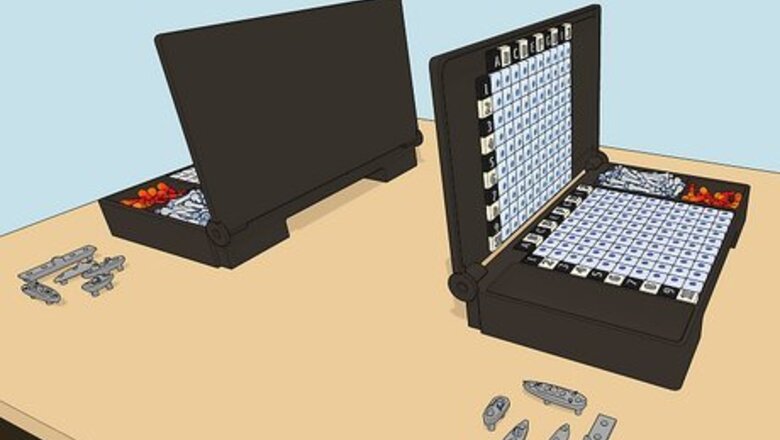
views
- Arrange your ships secretly on the bottom half of your box so that you and your opponent can’t see each other’s boards.
- To take a “shot” at your opponent’s ships, say the location on the grid you’d like to target out loud (i.e., A-1, D-4).
- After you take a shot, the other player announces “hit” or “miss” to signal whether or not their ship was hit. Then, on their turn, do the same as they take shots.
- Use the red and white pegs to track your hits and misses on the upper half of the box; a player wins when they’ve sunk all of their opponent’s ships.
Setting Up Battleship
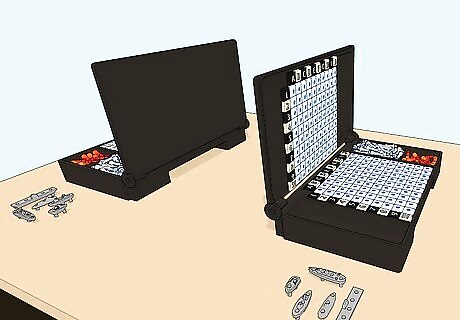
Sit opposite of your opponent with a Battleship box. The standard Battleship board game set comes with two boxes, one for each player. Each box opens to reveal two grids, one on each inside surface. As you set up, make sure you and your opponent are seated opposite one another so you can’t see the inside of one another’s boxes. If you don’t have enough boxes for two players, try playing on graph paper (as described below) or finding an online version of the game.
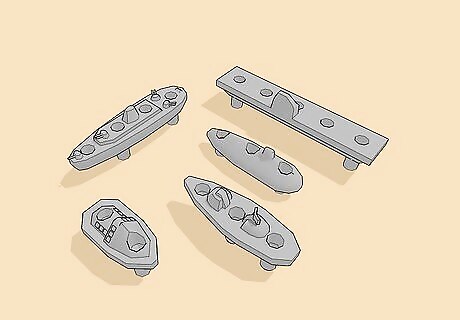
Check to make sure you have all the ship pieces. In Battleship, ships come in various lengths, taking up a different number of squares on the grid. You and your opponent should both have identical collections with 5 ships each as well as plenty of white and red pegs. The typical 5 ships include: The aircraft carrier (five squares long) The battleship (four squares long) The cruiser (three squares long) The submarine (three squares long, same as the cruiser) The destroyer (two squares long)

Arrange your ships secretly (while your opponent does the same). With the boxes open, you and your opponent must place your 5 ships on the lower grid of your boxes, anchoring each ship into the holes on the grid. Don’t look at what your opponent is doing, and make sure they can’t see your ship configuration either. Follow these rules while placing your ships: Ships can be placed horizontally or vertically, but not diagonally. You must place all five ships on the grid. Every ship must be completely on the grid. No ship can hang off the edge of the board. Ships cannot overlap each other. Once your ships are placed and the game has begun, you are not allowed to move your ships again.
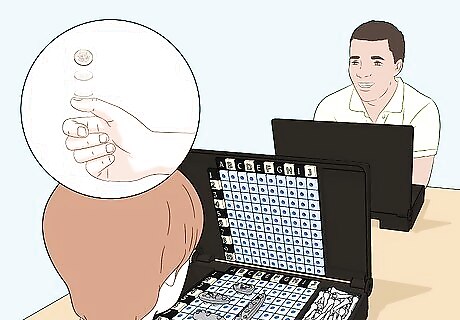
Decide which player will go first. If you and your opponent don't agree on who should go first right away, flip a coin or decide in some other randomized way. If you’re playing multiple games in a row, consider letting the player who lost the last game go first in the next one.
Battleship Game Rules
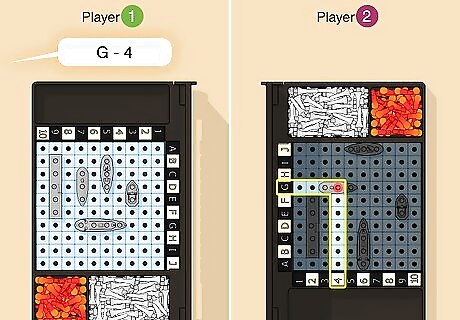
Take turns firing shots at enemy ships. To take a shot, pick a square on your target grid (the upper grid on your box without any ships). Find the coordinates corresponding to that square using the letters on the left and the numbers at the top of the grid. Call out those coordinates; then, your opponent must check their ocean grid (the lower grid) and let you know whether you hit one of their ships. Battleship typically has 10x10 grids, with letters A through J to the left and numbers 1 through 10 above. The square in the top left corner of the grid is “A-1” since it’s in the row labeled A and the column labeled 1. To the right of it is A-2, A-3, and so on. So, for example, you might say, “G-4” at the start of your turn, and your opponent would have to look at G-4 on their ocean grid to determine whether a ship is there. EXPERT TIP Ashton Wu Ashton Wu Board Game Expert Ashton Wu is a Board Game expert at Shelfside. After delving into the Yugioh tournament community while growing up, Ashton launched himself into the board gaming community in 2014 and went into reviewing board games as a career full-time in 2019. His YouTube channel Shelfside has over 35K subscribers and over 4 million views, assisted by written reviews on the Shelfside website and BoardGameGeek.com. He also consults with gaming companies to build high-quality gaming products. Ashton is a tournament commentator, board game playthrough director, and host of the Shelfside Podcast, where he talks about board games with his business partner, Daniel. He received a Bachelor of Arts in Economics at the University of California, Santa Barbara, in addition to the Technology Management Certificate. Ashton Wu Ashton Wu Board Game Expert Aim for the 4x4 center squares early in the game for a quicker path to victory. It's most effective to balance your fire between attacking the center and the edges during the game. This way, you can gather intel on the enemy ship's placement, increasing your chances of landing a hit and forcing your opponent to reveal their defenses.
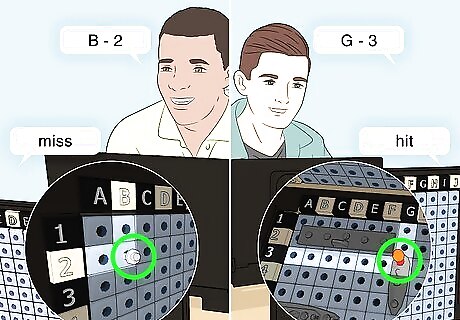
Mark all hits and misses on the target grid of your box. Use your upper target grid to keep track of each “shot” you take at the enemy ships. When your opponent says “miss,” after you name a coordinate, put a white peg into that hole on the grid. If your shot hits a ship successfully, place a red peg on that coordinate instead to mark where the ship is located. Once you manage to hit the opponent's ship, try aiming for squares next to it in the same row or column so that you can find the rest of the ship. You don't need to keep track of your opponent's misses on your own lower ocean grid if you don't want to. You do need to keep track of your opponent's successful hits, however, so you know when a ship has been sunk.

Respond “hit” or “miss” to each shot your opponent takes. When your opponent announces where they’re “shooting,” check that coordinate on the lower grid of your game box (where your ships are placed). Then, let them know truthfully whether they hit one of your ships or missed. If your opponent hits an empty square with no ships, say, “Miss!” If your opponent hits a square with a ship on it, say, “Hit!” If most “official” versions of the Battleship rules, players must also announce which ship was hit (for example, your submarine). However, many players don’t use this rule; it’s ultimately up to you whether you want to include it.
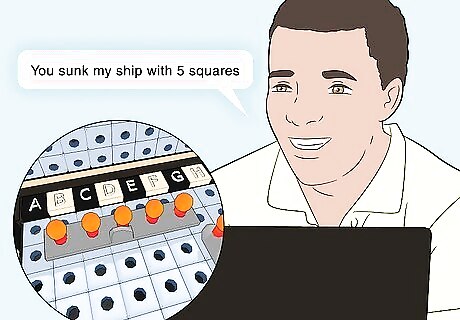
Announce when each ship sinks (while your opponent does the same). If every square of a ship gets “shot,” that ship is sunk. When one of your ships is officially sunk, tell your opponent, “You sunk my ship,” naming the type of ship that was sunk. Whenever you sink one of your opponent’s ships, they must do the same. The names of each sip are listed above—but if you forget them, you can always reference the number of squares the sunk ship has. For example, you might say, “You sunk my ship with 5 squares,” if your opponent sinks your aircraft carrier.
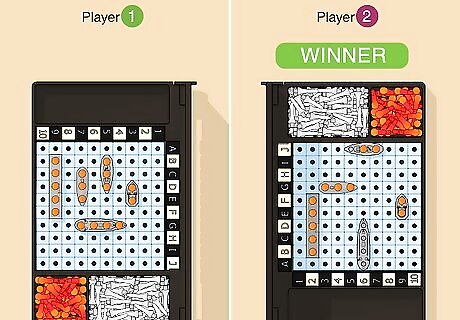
Take turns playing until you or your opponent has lost every ship. Battleship gameplay is simple: alternate taking one shot at your opponent’s ships per turn (whether or not that shot is successful). Whoever manages to sink all of their opponent’s ships first wins the game!
Strategy Advice for Players

Position your ships so that none of them are touching. Looking for the best battleship layout possible? There’s no “perfect” layout, but you can make things harder for your opponent by ensuring each ship is at least a space or two apart on your ocean grid. That way, your opponent is less likely to accidentally find another ship while trying to sink the first one. If your opponent hits one of your ships, odds are they’ll start calling out coordinates all around it to try and find the rest of the ship. Thus, if two of your ships are touching one another or close together in any way, your opponent will likely find and sink that ship, too. That’s why a spaced-out ship layout works best!

Set up at least one of your ships on the edge of the board. Players tend to fire more shots toward the middle of the grid—so you might be able to hide one of your ships by placing it along one of the edges of the grid (and gain an advantage over your opponent as a result). However, don’t position all of your ships along the edges of the grid; if your opponent senses a pattern, they might start only targeting edge coordinates.
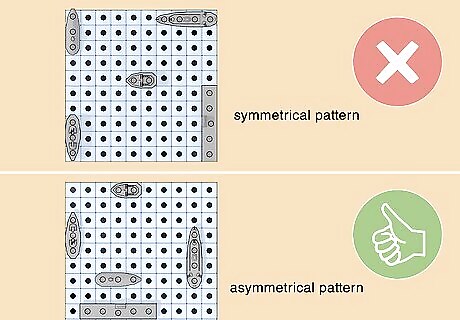
Arrange your ships in a random, asymmetrical configuration. Essentially, try not to mirror your ship placements. If your opponent instinctually starts looking for patterns, they might figure out where your ships are more easily when those ships keep mirroring one another. For example, if you have a ship in the upper right corner of the grid, don’t place a ship in the same position in the upper left corner. Generally, the name of the game is to be as unpredictable as possible. Luck is always a factor—but the harder you are to predict, the harder it’ll be for opponents to find your ships!
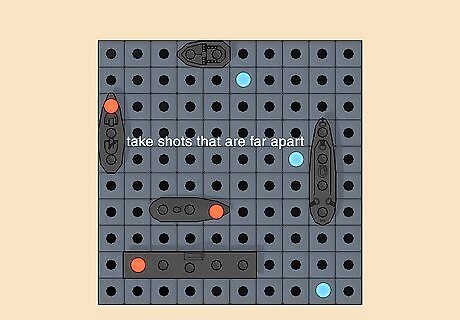
Cover a wider area instead of bunching up your shots. At the start of the game, you won’t have any idea where your opponent is hiding their ships—which means the quickest way to find out is to fire shots all over the grid (instead of firing shots that are adjacent or diagonal to each other). Firing shots in diagonal lines down your grid (like A-1, B-2, and C-3, for example) can be a sound strategy after the first couple of turns. However, if you haven’t landed any hits yet, the best strategy is to take shots that are far apart in different parts of the grid so you’re covering more ground.
Battleship Game Variations
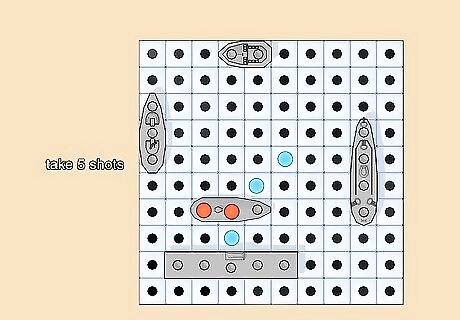
Try the original “salvo” rules. Once you master the basic game, you might want to try “salvo,” which is more challenging. In salvo, fire five shots at once on your turn. Your opponent must then respond as normal, telling you which shots were hits and which were misses—but only after you’ve selected five squares to aim for. This version of the game dates back to at least 1931!
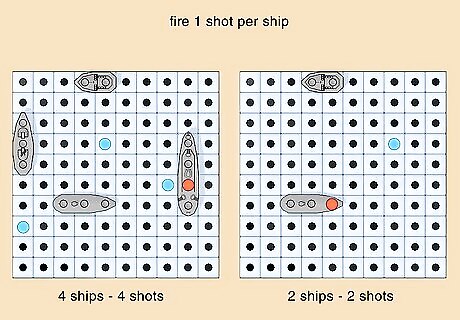
Reduce the number of shots you get as you lose ships. Increase the tension and reward the player who sinks the first ship by adding this condition to the salvo rules above. Instead of firing five shots per turn for the whole game, you and your opponent can only fire one shot per surviving ship. So, if none of your ships have sunk, you can fire five shots in a single turn. However, say you lose your cruiser and are down to four ships. In that case, you’d only get four shots per turn.

Make the game even more challenging with advanced salvo rules. Play with the original salvo rules above, but don't tell the opponent exactly which shots were hits or misses. Instead, tell them how many of the shots hit and how many missed. This results in a complicated game and is only recommended for advanced players. Because you don't know for sure which squares were hits, the ordinary red peg and white peg system probably won't work well for this variation. Instead, you may need a pencil and pad of paper where you can write down each salvo (and your opponent's response).
How to Play Battleship on Paper
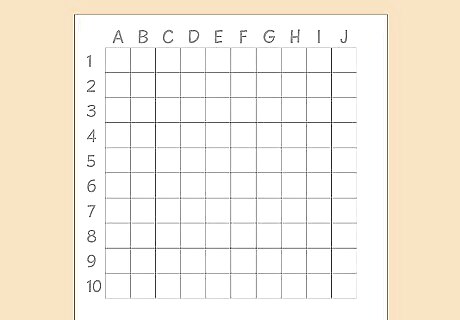
Create your own game boards by outlining four 10x10 grids. Draw four boxes on the graph paper, each one 10 squares wide and 10 squares long. Then, label the grids: starting from the top right corner of each, label the squares in the far right column A through J, and the squares in the top row 1 through 10. Then, give two boxes to your opponent and keep two for yourself. For good measure, label one of your grids “my ships” and the other “enemy ships,” and have your opponent do the same to theirs.
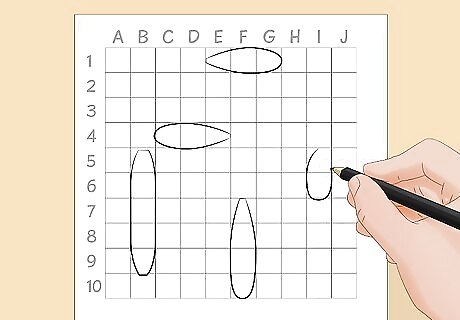
Draw the outlines of your ships on your grid. Hide the box labeled "my ships" from the other player, and draw a thick outline of five ships anywhere within its boundaries. Each ship is one square wide and ranges in length: Draw one ship five squares long (the aircraft carrier) Draw one ship four squares long (the battleship) Draw two ships three squares long (the cruiser and the submarine) Draw one ship two squares long (the destroyer)
Play Battleship using the standard game rules. Battleship doesn’t change when using graph paper, so use the instructions above. Instead of using pegs, draw successful hits with Xs and misses with dots, or use any system of symbols you find easy to understand. Use the box labeled "enemy ships" to keep track of the shots you've taken and the box labeled "my ships" to keep track of your enemy's shots.














Comments
0 comment